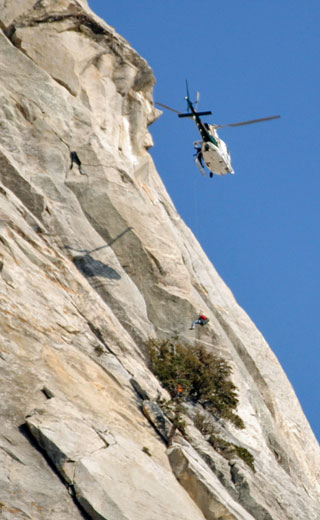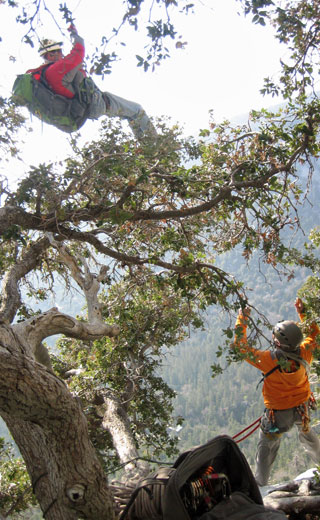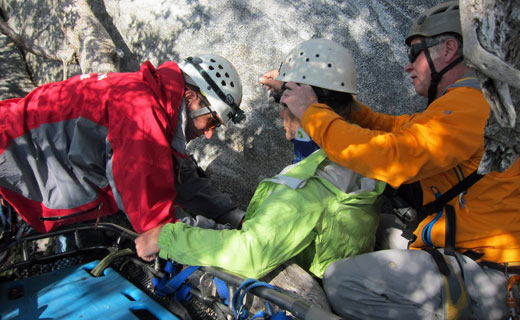Rescue Tahquitz Rock
|
April 27, 2013 |
Written by - Lee Arnson with the help of Helene Lohr
RMRU has just been called out for a helicopter rescue on Tahquitz rock. I swing my truck into place below the Helipad at Keenwild and breathe a sigh of relief as I see Les, one of our most capable Technical Rock Rescuers, already deep in conversation with the Technical Flight Officer (TFO) of the Sheriffs Aviation Unit. A rock climber has taken a serious 40 foot plus fall onto a small ledge about 300 feet up from the base of the rock. He was initially unconscious and is now reporting severe head, neck and chest pain. Cal-Fire flew in to assess, and deemed the situation too dangerous to approach with a larger helicopter and no high angle rock experience. The decision was made to call in RMRU and the Riverside Sheriff Aviation Unit, but to use CDF's litter and packaging system.
This will be the first time ever that we are sharing gear with CDF. Les and I kneel down with their crew to receive a hands-on tutorial on their litter system. I'm impressed with its straightforwardness. The strapping system is efficient and will be an asset in the conditions we're expecting on the rock. They supply us with a c-collar and additional medical supplies tailored to deal with the expected trauma from our subject's fall. RMRU Rescuer Craig Wills is on scene to serve as communications with our call captains and ground crews, while Ralph Hoetger and Helene Lohr will work base at Humber Park.
After the tutorial I grab my backpack. Les and I do a quick cross check of gear. We'll be going in loaded for bear, backpacks bulging with more than 60 lbs. equipment. We are fully geared to be in and out within the hour, or to stay for the next 2 days. Between us we have hundreds of feet of rope in case we need to do a full technical lower. Hopefully the helicopter will be able to pull us out, but assumptions can get you in trouble. You never know when the helicopter's action will be limited by weather or other conditions and you will need to switch to old school technical methods to lower the subject off the rock. Rescuers that go in without this preparation can quickly become victims themselves.
We board the A-star with our packs already strapped on and good to go. The back seats have been removed to make room for the litter. We sit on the cool metal floor. I reach behind me for the end of the seat belt protruding from the deck. As it clicks together I give the TFO thumbs up, ready to go. Within moments we're surging into the air. With our huge packs and rescue gear Les and I are wedged into the small cabin like sardines. Manny, our TFO balances himself outside on the skid, securely clipped into the helicopter with a bird's eye view of the pine covered ravines rushing by below.
The bird turns to the North. I see Tahquitz Rock lit by the afternoon sun ahead of us. 'Oh man, what am I getting myself into this time?' As a rescuer you never really know what lies ahead. All you know is that somebody is hurt, and it's your job to help them. As the rock looms in front of us, I have a gut feeling that all our years of experience are going to come to a head right now. We fly up near the massive face of the rock. Kevin, our pilot, circles the helicopter, searching the surface of the rock for our subject. Manny points him out, wedged on a tiny ledge several hundred feet up. His climbing partner waves her arms in wide arcs at us. Kevin puts us into a hover that seems impossibly close, blades spinning a mere 20 feet off of the rock. The courage and skill it takes to fly a mission like this are incredible. The wind pouring over the ridgeline and the rotor wash against the rock cause unpredictable conditions that even the best pilot can't predict.
Les clips into the hoist and scoots past me towards the open door. Kevin holds position, while Manny lowers Les into a bushy scrub oak sprouting precariously out of the ledge. Les uses its branches to pull himself into relative safety and quickly anchors himself in. As soon as Les unclips from the hoist, Kevin pulls the helicopter off to a safe distance. Underneath the thick overgrowth I can just make out Les greeting the subject and his wife. He immediately secures them safely to the face of the rock and then sets anchors for me. He looks up and waves to the copter to signal that he's ready for me to be lowered.
We carefully approach the face of the rock again. Manny hands me the hoist hook. I clip it into my harness, check, and double check that it is closed and that my carabiner is locked, before I undo my seat belt and scoot forward across the floor. I sit on the edge, put my feet on the skid, stand, and pivot to face the TFO, my hand gripping his chest carabiner for support. Now the only thing keeping me from falling hundreds of feet is the connection of the hoist hook to one locking carabiner on my belay loop. I take a slow deep breath, look at Manny and nod. I drop smoothly into the open air, the rotor wash reflecting back from the rock and buffeting my body. My full pack is a constant heavy pressure on my shoulders pulling me backward. I tighten my grip on the cable to keep myself upright. The ledge approaches quickly and I can see Les below me in the branches, leaning forward, ready to clip me in to our safety line.

Lee being lowered, Les orange shirt in tree
Photo by Cid Castillo, Idyllwild
Suddenly the world jerks, sways and drops. The rock swings away from my view and I'm flying backward, wind whistling in my ears and boulders and pines rushing past below my feet. A drastic change in the wind has hit the helicopter, radically cutting its lifting power. The pilot's only choice is to peel away from the rock or risk crashing into its face. His quick action and skillful flying have saved us, but now I'm in a wild pendulum underneath the copter on the hoist line. My heart pounds, but I feel strangely calm inside. Flying like a bird, I see Idyllwild spread surreally out far below me. On the tail end of each upswing I powerlessly watch as the blades get closer and closer. Manny quickly recognizes the risk and sets to work lowering the hoist at the apex of each swing to stop my upward momentum. Finally quieting my swing, he hoists me back up into helicopter. As I climb back into the helicopter Manny yells over the thrum of the blades to see if I'm alright, I give him the thumbs up to let him know I'm OK and good to go for another attempt.

Lee coming into the tree the second time
Photo by Subjects Wife and Climbing Partner
Kevin makes another couple of passes to get a feel for the wind and then sets the helicopter into a hover again. Out the door I go. This time the hoist goes smoothly and before I know it I'm landing deep inside the scrub brush. Les clips me into the safety line right away. I release the hoist and the helicopter pulls away. Once we are safely situated I radio in to confirm we are both on the rock and secured. The helicopter edges in again to lower the CDF litter and we lean out from our anchors to grab it as it spins in the wind. We unclip it and secure it to our line. With a wave and a nod Star-9 peels away, heading back to Keenwild to conserve fuel until we call them for pickup. We make our way down onto the belay ledge, the area about size of large coffee table, with vertical rock on all sides and a sheer 300 foot drop off.

Rescuers packaging Subject
Photo by Subjects Wife and Climbing Partner
Les briefly introduces me to subject and his wife. We immediately begin packaging him into the litter. It's difficult work. The litter takes up the floor of the ledge. We are left perched on the edge of a sheer drop, leaning into our anchors while working to strap him in. Despite the warmth of the day the subject is shivering uncontrollably, a potential sign of dangerous hypovolemic shock. I give him my coat before we tighten the 3 layers of webbing and buckles to secure him for the hoist. There's not much that we can provide in the way of advanced care right now. The best way to save his life is to get him off the rock and into the helicopter as safely and efficiently as possible so that he can get to a hospital for proper care. We have him strapped in, but now have to find a way to bring the hoist hook far enough in to attach to the litter. The helicopter won't be able to get close enough to the rock to lower it directly to us, besides; we can't hoist the litter through the thick shrub engulfing the ledge. We need to get him out in the open. We'll have to slide the litter down off the ledge onto the face of the rock so that the hoist can reach the spider attached to the litter.
Les calls in to the helicopter to stand by for a hoist. We set up a lower, with the amazingly calm and collected wife acting as belay. As we slide him off the edge of the sheer drop off the litter tilts slowly forwards. The subject's feet go down, and his head tilts up. After several seconds of lowering, the subject blurts out; "I'm losing blood pressure, I'm going to faint..." His face goes slack. Les and I make eye contact. Oh man. We immediately start to raise the litter back up. Les radios in to call off the bird. Without saying anything to each other, we know this is going to be a very tricky maneuver to get this guy off this rock. Les now has the weight of the foot end of the litter balancing on his knee, while I am holding down the head end; all the while we are both at the end of our anchors just really hanging on for dear life. The subject does regain consciousness and we tell him this is going to be one wild ride getting on board the helicopter and we feel our next attempt will be successful. Les and I look at each other, and because of friendship and training we know we can pull this rescue off safely.
We call for the bird to come back, and as it goes into a hover, Manny starts to lower the hoist cable, Les and I are trying our best to keep the litter as level as possible, while at the same time we are both extending our arms as far out as possible to catch the hoist hook. The rotor wash is so intense at this point it feels like you are just going to be blown right off the face of the rock and never heard from again. Les does this amazing move while the litter is still balanced on his knee and somehow he is able to reach out and grab the hook, I have the spider in my hand and Les automatically clips into it. The litter is now safely clipped to helicopter, but we need to unclip it from our system so it can be raised up. There is no slack- our belay is maxed. Every time we rise to get slack the heavy weight of the litter plus subject slides forward and takes up the excess. In order to get the slack we need to free the litter we need precise timing. Everything happens in quick succession. Les yells for slack over the pelting roar of the rotor wash, the subject's wife gives us rope; Les unclips the litter while giving the helicopter the hand signal for a raise. The litter lifts and swings smoothly out and up away from the rock. I let out a long sigh and realize I've been holding my breath. What a rush!
Star-9 disappears over the forested ridge into the direction of the Keenwild helipad to transfer our subject to Mercy Air. Before it even seems possible the helicopter is hovering over us again for a pickup. One by one we are hoisted back to safety. I smile and Les slaps me on the shoulder, "Good job buddy!" We grin at each other. It's time to head back to La Casita for a celebration with our team and some retelling of an incredible experience.
RMRU team members present: Lee Arnson, Ralph Hoetger, Helene Lohr, Les Walker, and Craig Wills.
Assisting agencies: Riverside County Shiriffs Department (Pilot Kevin Boss and TFO Manny Romero, without whom this rescue would not have gone down in this fashion).